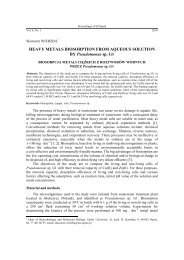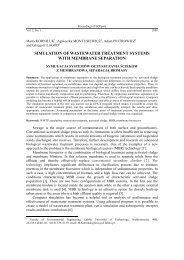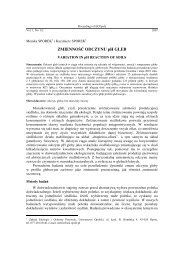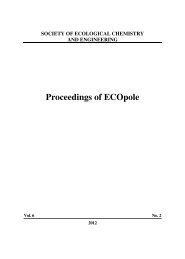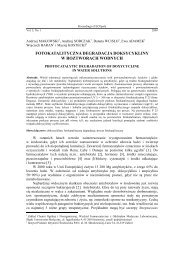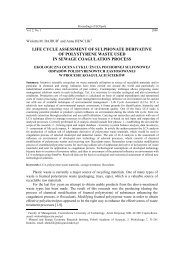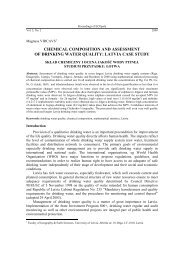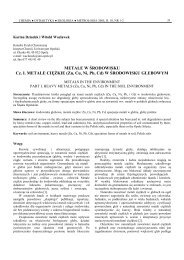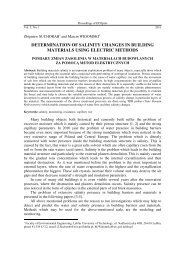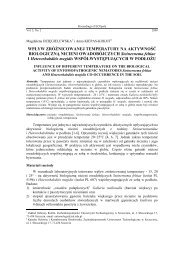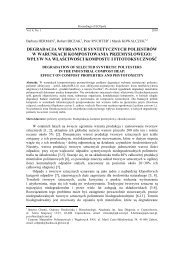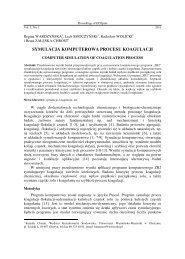Download part 3 of the issue - Uniwersytet Opolski
Download part 3 of the issue - Uniwersytet Opolski
Download part 3 of the issue - Uniwersytet Opolski
You also want an ePaper? Increase the reach of your titles
YUMPU automatically turns print PDFs into web optimized ePapers that Google loves.
Literatura<br />
Kwasy halogenooctowe - usuwanie w bioreaktorze z poliamidową, enzymatyczną membraną …<br />
[1] Dojlido JR, Zbieć E. Kwasy halogenooctowe w wodzie do picia. Gaz, Woda i Technika Sanitarna.<br />
1998;5:221-225.<br />
[2] Batterman S, Zhang L, Wang S. Quenching <strong>of</strong> chlorination disinfection by products formation in drinking<br />
water by hydrogen peroxide. Water Res. 2009;34(5):1652-1658.<br />
[3] Zbieć E, Dojlido JR. Uboczne produkty dezynfekcji wody. Ochr Środow. 1999;3(74):37-44.<br />
[4] Kucharski M, Koprowicz D. Chloroacetic acids in drinking water as ozonation and disinfection chlorine byproducts.<br />
Polish J Environ Stud. 2007;16(2A):150-157.<br />
[5] Symons JM. Treatment techniques for controlling trihalomethanes in drinking water. J AWWA. 1975;<br />
47(67):634-642.<br />
[6] Peters RIB, Erkelen S, Leer EWB, Glan L. The analysis <strong>of</strong> halogenated acetic acids in dutch drinking water.<br />
Water Res. 2008;25(4):473-477.<br />
[7] Rozporządzenie Ministra Zdrowia z dnia 20 kwietnia 2010 r. zmieniające rozporządzenie w sprawie jakości<br />
wody przeznaczonej do spożycia przez ludzi. DzU, Nr 72, 466.<br />
[8] Kowalska M, Bohdziewicz J. Usuwanie kwasu monobromooctowego z zastosowaniem ultrafiltracyjnych<br />
membran enzymatycznych. Monografie Komitetu Inżynierii Środowiska PAN; 2008; 126-135.<br />
[9] Kowalska M, Bohdziewicz J. Usuwanie kwasu dichlorooctowego z wody enzymatyczną membraną<br />
ultrafiltracyjną. Monografie Komitetu Inżynierii Środowiska PAN 2010; 132-147.<br />
[10] USEPA, Determination <strong>of</strong> haloacetic acids and dalapon in drinking water by liquid-liquid extraction,<br />
derivatization and gas chromatography with electron capture detection, Method 552.2, Rev. 1.0, 1995.<br />
HALOACETIC ACIDS - THE REMOVAL FROM WATER IN BIOREACTOR<br />
WITH POLYAMIDE ENZYMATIC ULTRAFILTRATION MEMBRAN<br />
Division <strong>of</strong> Sanitary Chemistry and Membrane Processes, Institute <strong>of</strong> Water and Wastewater Engineering<br />
Faculty <strong>of</strong> Energy and Environmental Engineering, Silesian University <strong>of</strong> Technology, Gliwice<br />
Abstract: The results <strong>of</strong> <strong>the</strong> study focused on <strong>the</strong> removal <strong>of</strong> halogenated acetic acids (HAA) from water by<br />
means <strong>of</strong> <strong>the</strong> hybrid process ultrafiltration-biodegration are presented in <strong>the</strong> article. The study was carried out in<br />
<strong>the</strong> reactor equipped with <strong>the</strong> ultrafiltration membrane, on <strong>the</strong> surface <strong>of</strong> which enzymes responsible for<br />
degradation <strong>of</strong> HAA were immobilized. The feed solution introduced to <strong>the</strong> process comprised <strong>of</strong> <strong>the</strong> mixture <strong>of</strong><br />
five HAA (MCAA, DCAA, TCAA, MBAA, DBAA) <strong>of</strong> concentration 1 mg/dm 3 each. Enzymes immobilized on<br />
<strong>the</strong> support were isolated according to Hageman method from bacteria separated from activated sludge adapted for<br />
HAA degradation. Acinetobacter, Arthobacter, Pseudomonas and Bacillius were dominant types <strong>of</strong><br />
microorganisms. The study was carried out in reactor <strong>of</strong> volume 500 cm 3 equipped with magnetic stirrer and <strong>the</strong><br />
flat membrane <strong>of</strong> area 50 cm 2 . The aim <strong>of</strong> <strong>the</strong> experiment was to determine <strong>the</strong> optimal conditions for <strong>the</strong> hybrid<br />
process ultrafiltration-biodegradation <strong>of</strong> HAA (transmembrane pressure, linear feed flow rate, length <strong>of</strong> <strong>the</strong><br />
process). Additionally, <strong>the</strong> method <strong>of</strong> analysis <strong>of</strong> degraded xenobiotics concentration using HPLC and HAA<br />
extraction with ETBE was developed. Obtained results allowed to assign <strong>the</strong> optimal operating conditions <strong>of</strong> <strong>the</strong><br />
hybrid ultrafiltration-biodegradation system ie transmembrane pressure 0.1 MPa and linear feed flow rate -<br />
0.5 m/s. The highest membrane process capacity and HAA removal effectiveness were obtained under those<br />
conditions. The total removal <strong>of</strong> dichloroacetic acid and monobromoacetic acid lasted 3.5 h and 4.5 h for <strong>the</strong> rest<br />
<strong>of</strong> <strong>the</strong> investigated acids applying optimal operation parameters. The capacity <strong>of</strong> <strong>the</strong> process determined by <strong>the</strong><br />
measurement <strong>of</strong> volumetric permeate flux did not change in time.<br />
Keywords: halogenacetic acids, immobilization, biodegradation, ultrafiltration enzymatic membranes<br />
355



